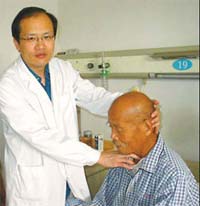| Home / Health / News | Tools: Save | Print | E-mail | Most Read |
| Hope for Last-stage Lung Cancer Patients |
| Adjust font size: |
In 1998, Zhang Fuqin was diagnosed with late stage lung cancer. After examining lab images, doctors at a local hospital in Jiangsu Province decided not to go ahead with surgery as the tumor was too close to the gullet and a major artery. They did not have much confidence that they would be able to keep the gullet or the artery intact during the operation. If either was hurt, the result could be fatal. Zhang died later that year.
Doctor Li Jian says his minimally-invasive thoracic surgery skills can help remove lung tumors even in late stages and dramatically improve survival rates. Removing such tricky lung tumors now pose no problem said Li Jian, director of the Thoracic Surgery Department, No 1 Hospital affiliated to Peking University. Li and his team have invented a technique not just to successfully remove such tumors but also to reduce the post-operative complications and prolong the life span. Last November, Li and his team explained this new technique to doctors from more than 30 hospitals from around China at the Great Hall of People, and followed this up with a week-long training session. Organized by the Beijing Health Bureau and Li's hospital, the event was aimed at promoting Li Jian's thoracic surgery skills, which feature minimally-invasive surgery with the aid of a Thoracoscope. Lung cancer has for years ranked as China's No 1 killer disease. By the time they are diagnosed, most patients are already in the late stages and need surgery. In North America, where surgery for removing lung tumors has been carried out for much longer, survival rate after five years has reached 15 percent. But in China the figure is much lower. In Shanghai for example, the survival rate after just three years is only 14.8 percent. Besides being able to operate on tumors embedded in hard-to-operate places, Li and his team claim to have almost completely solved the problem of damage to nerves that was the cause of severe pain in about half the patients undergoing open-thorax surgery. Of the more than 2,000 patients with lung tumors that Li has operated upon, none he says, suffered nerve damage. Early stage post-surgery pain has also been very minor and Li puts survival rates with his thoracic surgery skills at 56 percent after five years, and 31 percent after 10 years. His technique can be applied to most ordinary thoracic surgery that used to demand an open chest operation, and cost about the same. Another difficulty that Li said he had been able to solve is gullet rebuilding after tumor removal. Li has managed to avoid the problem of eventual leaking, which continues to persist at other hospitals worldwide, he claims. Explaining his successes as a thoracic surgeon for more than a decade, Li said: "Unlike others who value speed, we look to achieve the best possible result. "If you don't cut very clean, the tumor will grow again even after chemotherapy." Also, at most other hospitals the tumors are plucked out by hand but Li uses electric knives, which enable a smaller and more efficient cut. Besides, at his department, patients are not put through chemotherapy right after surgery. "We believe this helps the patients to recover faster," he said. (China Daily May 22, 2007) |
| Tools: Save | Print | E-mail | Most Read |
 |
| Related Stories |
|
